Historic Manchester
Explore hidden histories, historic photos, and things you never knew about Manchester from the collections and archives of Historic England.
Discover Manchester's listed buildings and places
Introducing some of Manchester's most significant historic sites, curated from the National Heritage List for England. Skip this section and go to place by numbers
Cavendish primary school including detached annexe and front boundary wall, gatepiers, gates and railings
Manchester
A local authority education committee primary school begun in 1904, by Ernest Woodhouse, in Jacobean Revival style.
Charter Street Mission (formerly Charter Street Ragged School and Working Girls' Home)
Manchester
A working girls’ home, ragged school and mission hall of 1892 and 1900 by Maxwell and Tuke, comprising a three-and-four-storey trapezoidal...
Former Nicholls Hospital including gymnasium, governor's house, stone setted and flagged forecourt, boundary walls and gates, stone gate piers on Ford Street and Devonshire Street, and two granite memorials in the forecourt
Manchester
A bluecoat school designed 1865 to 1867 and built 1878 to 1880, by Thomas Worthington for Benjamin Nicholls, with a governor's house of approximately...
Manchester Oxford Road Station (including platform structures)
Manchester
Railway station building and platform structures, 1958-60, by Max Clendinning of British Railways' Midland Region with Hugh Tottenham of the Timber...
Train shed and undercroft at Manchester Piccadilly Station
Manchester
Train shed set above a rail-served undercroft, 1866, extended 1883 with significant remodelling 1958-1966 and 1998-2002.
Ashburne Hall (Lees, Mary Worthington, Ward and Central block), including the Alice Barlow memorial gates and Ashburne Hall Lodge
Manchester
A purpose-built women's hall of residence by Sir Percy Scott Worthington, 1910-1933, including the Alice Barlow memorial gates, 1924, and Ashburne...
Pall Mall Court, Including Raised Piazza And Podium To The West Side
Manchester
Commercial office building, 1966-8 by Harry Teggin of Brett, Pollen & Teggin in association with A H Brotherton and Partners, and the engineers, Cyril...
New Century House, Including Its Attached Conference Hall and Abstract Concrete Relief Wall in the Entrance Piazza
Manchester
Office building and attached conference hall, 1959-63, by G.S.
Chorlton Library
Manchester
Library, 1914, by Henry Price. Red brick with Portland stone dressings. Single-storey and flat-roofed. Edwardian Baroque style.
The Hanging Bridge immediately south of Manchester Cathedral
Manchester
Multi-span bridges are structures of two or more arches supported on piers.
Roman Catholic Church of St Chad and attached Presbytery, and Boundary Walls
Manchester
A Roman Catholic church with attached presbytery, now an oratory, of 1847, by Weightman and Hadfield of buff sandstone in Perpendicular Gothic style.
Old Trafford Bowling Club Pavilion
Old Trafford
An amateur bowling club pavilion of 1877 by John Bowden in a Tudor Revival style over two storeys, with an unusually ornate interior.
Former District Bank (West Didsbury Branch)
Manchester
Former District Bank, 1914-15, by Barker, Ellis & Jones of Manchester, brick with applied mock timber framing and cement render panels, deep pitched...
Hulme Hippodrome
Manchester
Theatre, 1901, by JJ Alley. Red brick with white glazed-brick dressings, slate and corrugated-metal covered roofs. Three storeys plus basement.
Manchester Quaker Meeting House, boundary walls and steps
Manchester
Quaker Meeting House built in 1828 to a design by Richard Lane, altered in the 1860s by Alfred Waterhouse, and with further alterations in 1923 and...
Sculptural Wall
Manchester
Sculptural wall and sound buffer, 1968, by Antony Hollaway. Read the official list entry to find out more.
Marlsbro House
Manchester
Marlsbro House, a factory building of 1823, is listed at Grade II for the following principal reasons: as an early-C19 factory in the centre of the...
Former doctor's surgery
Manchester
Doctor’s surgery and house of around 1887, adapted and converted from an early-C19 house, with further later alterations.
Hulme Lock Branch Canal
Manchester
A branch canal of 1838 with modifications of 1962, comprising a canal arm and lock constructed in a combination of coursed sandstone masonry and brick...
Manchester University Rutherford Building and Hopkinson Memorial Wing
Manchester
University physics laboratory, now administrative offices.
Manchester General Cemetery
Manchester
A public cemetery developed by a private company and opened in 1837. Read the official list entry to find out more.
3 St Mary's Parsonage
Manchester
Textile warehouse of 1868, with repair after the Second World War and C20 alterations. Venetian Gothic style.
Section of an early medieval boundary ditch known as the Nico Ditch in Platt Fields 480m SSE of Platt Hall
Manchester
A small number of substantial and defensible boundary features have been identified as frontier works marking territories in the early medieval period.
Manchester Southern Cemetery
Manchester
A public cemetery opened in 1879, designed by the City Surveyor, J G Lynde, with buildings by H J Paull, and extended in the C20.
Prescott'S Almshouses (Including Associated Boundary And Garden Walls, Gateways And Gate Piers, And Outbuildings)
Reddish
Prescott's Almshouses is designated at Grade II for the following principal reasons: *
Roman Catholic Church of St Mary (The Hidden Gem)
Manchester
Roman Catholic church, 1844 to 1848 by Weightman and Hadfield in a Rhenish Romanesque style. Read the official list entry to find out more.
Electricity Junction Box in Castlefield canal basin, Manchester
Manchester
Decorative cast-iron electricity junction box of early C20 date by Hardy and Padmore of Worcester.
Chorlton War Memorial
Manchester
First World War memorial, c1920, with later additions for the Second World War. Read the official list entry to find out more.
Cobden House, 19 Quay Street
Manchester
Cobden House, 19 Quay Street, is listed at Grade II for the following principal reasons: with nearby late-C18 and C19 town houses on Byrom Street and...
Electricity Junction Box
Manchester
Decorative cast-iron electricity junction box of the early C20 by Hardy and Padmore. Read the official list entry to find out more.
Gardens Hotel and shops
Manchester
Textile shipping warehouses, one of mid-to-late C19 date, and one of 1904 by W and G Higginbottom, both with ground floor shops and later used as...
Former Grape Street railway bonded warehouse
Manchester
Former railway bonded warehouse, built 1867 to 1868 for the London and North Western Railway; it underwent internal modifications in the C20 and early...
Jubilee Fountain, Albert Square, Manchester
Manchester
Fountain. 1897 to designs by Thomas Worthington, with sculpture by John Cassidy. Restored in 1997. Grey and red granite, sandstone, bronze.
Section of an early medieval boundary ditch known as the Nico Ditch on Denton golf course 320m south west of Lodge Farm
Tameside
A small number of substantial and defensible boundary features have been identified as frontier works marking territories in the early medieval period.
The Playhouse, Hulme
Manchester
Theatre, 1902, by JJ Alley. Red brick with white glazed-brick dressings, slate roofs. Three storeys plus basement.
47 Piccadilly including warehouse facing Back Piccadilly
Manchester
Town house with attached rear warehouse, probably 1776 and mid-C19 respectively, the warehouse incorporating C18 fabric, both with alterations.
Explore more
Search for more listed placesHistoric Manchester through time
The National Heritage List for England contains hundreds of details about buildings and places, including the periods in which they were built and the uses they've had over the years. Explore how your local area has changed through time. Skip this section and go to aerial photos
Roman AD 43 to AD 410
Britain was invaded by four legions of the Roman army in AD 43, who relatively rapidly conquered England from landing points in Kent. Parts of Wales and Scotland soon followed.
Roman culture brought urbanism, monumental buildings, wide-ranging religious beliefs, writing, and strong social hierarchy. The Roman administrative system was withdrawn in AD 410.
Early medieval AD 410 to AD 1066
This period, often associated in England with Anglo-Saxons and Vikings, saw a reduction in urban living from the Roman period and increased migration from northern Europe.
Traces of this period can be found in cemeteries, particularly in artefacts and in some of the very early churches, as this period also saw the growth of Christianity in Britain.
Medieval AD 1066 to AD 1540
This period, sometimes known as the Middle Ages, began with the Norman invasion in AD 1066. It saw a significant rise in military and defensive buildings such as castles and earthworks, as well as religious houses dominating a largely agricultural landscape.
The monarchy and Church dominated the period, which also saw the break with the Roman Church and the English reformation.
Post medieval AD 1540 to AD 1901
The Post-Medieval period brought seismic changes to life in England, with religious reformation leading to the democratization of worship and the destruction of hundreds of religious houses.
In parallel, there was a huge expansion of scientific study and enlightenment that permanantly altered the nation's social structure and landscape. Industrialization and mass production lead to wider global trade, emigration, and immigration.
20th century AD 1901 to AD 2000
The 20th century saw an incredible expansion of England's transport networks, with suburban growth shadowing rapid infrastructural expansion. The establishment of state schools, hospitals, and modern technical colleges, with new architectural styles, radically changed the appearance of towns and cities.
Two catastrophic world wars and the 1918 pandemic also brought unprecedented change, altering England's built environment and social structures forever.
Roman AD 43 to AD 410
Britain was invaded by four legions of the Roman army in AD 43, who relatively rapidly conquered England from landing points in Kent. Parts of Wales and Scotland soon followed.
Roman culture brought urbanism, monumental buildings, wide-ranging religious beliefs, writing, and strong social hierarchy. The Roman administrative system was withdrawn in AD 410.
Early medieval AD 410 to AD 1066
This period, often associated in England with Anglo-Saxons and Vikings, saw a reduction in urban living from the Roman period and increased migration from northern Europe.
Traces of this period can be found in cemeteries, particularly in artefacts and in some of the very early churches, as this period also saw the growth of Christianity in Britain.
Medieval AD 1066 to AD 1540
This period, sometimes known as the Middle Ages, began with the Norman invasion in AD 1066. It saw a significant rise in military and defensive buildings such as castles and earthworks, as well as religious houses dominating a largely agricultural landscape.
The monarchy and Church dominated the period, which also saw the break with the Roman Church and the English reformation.
Post medieval AD 1540 to AD 1901
The Post-Medieval period brought seismic changes to life in England, with religious reformation leading to the democratization of worship and the destruction of hundreds of religious houses.
In parallel, there was a huge expansion of scientific study and enlightenment that permanantly altered the nation's social structure and landscape. Industrialization and mass production lead to wider global trade, emigration, and immigration.
20th century AD 1901 to AD 2000
The 20th century saw an incredible expansion of England's transport networks, with suburban growth shadowing rapid infrastructural expansion. The establishment of state schools, hospitals, and modern technical colleges, with new architectural styles, radically changed the appearance of towns and cities.
Two catastrophic world wars and the 1918 pandemic also brought unprecedented change, altering England's built environment and social structures forever.
Aerial photos of Manchester
Historic aerial photography shows the growth and changes in England's urban and rural landscapes, revealing secrets that are impossible to see from the ground. Skip this section and go to archive images

Manchester
The Royal Infirmary and Whitworth Park, Manchester, 1926
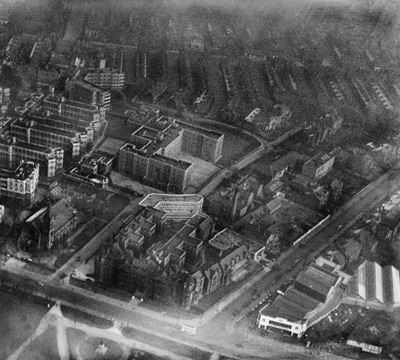
Manchester
St Mary's Hospital, Manchester, 1939

Manchester
Church Street, Thomas Street and environs, Manchester, 1932
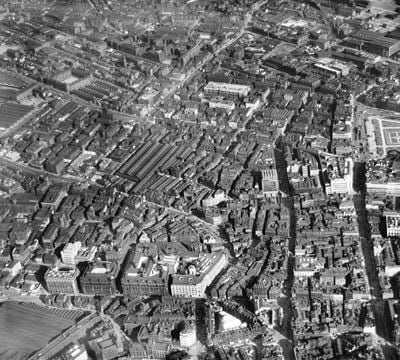
Manchester
Shude Hill and environs, Manchester, 1937
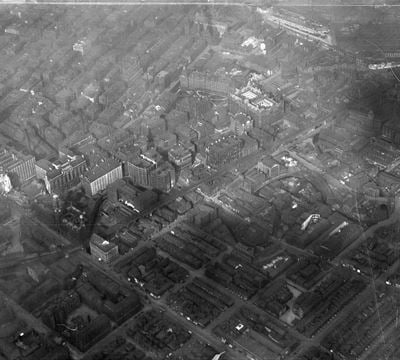
Manchester
The River Medlock and environs at Princess Street, Manchester, 1927
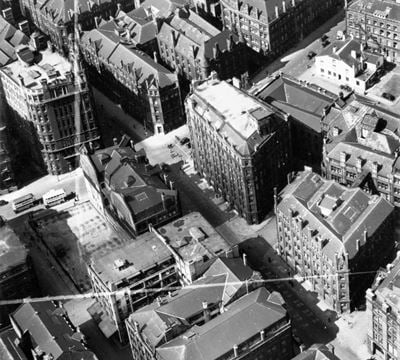
Manchester
Whitworth House off Princess Street, Manchester, 1951
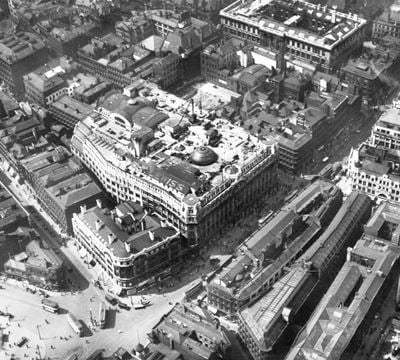
Manchester
Lewis's Department Store and environs, Manchester, 1927

Manchester
View looking along Mosely Street to the G-Mex Centre, Manchester, 1992
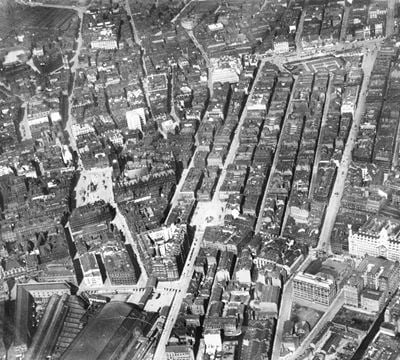
Manchester
The city centre, Manchester, 1927

Manchester
The city centre, Manchester, 1951
Historic England Archive images of Manchester
The Historic England Archive holds and cares for over 15 million images, from the 1850s to the present day. Discover stunning images of Manchester's past. Skip this section and go to stories about heritage
Charles George Harper Collection
Manchester
Date created: 1892 - 1933
'Ye Olde Rover's Return' public house on Shude Hill
Eric de Mare
Ancoats, Manchester, Manchester
Date created: 1945 - 1980
Exterior view of Rochdale Canal Warehouse in Manchester showing a detail of shipping holes in the south facade
John Laing Collection
East Didsbury, Manchester
Date created: 12 Sep 1989 - 13 Sep 1989
Shoppers at the fish counter at the Tesco supermarket in East Didsbury, Manchester
London, Midland and Scottish Railway Company
Manchester
Date created: 04 Jun 1928
Two Fry's vans parked outside the grain warehouse at Ancoats Station, with two figures stood in the building's doorway
Nigel Temple Collection of Postcards of Parks and Gardens
Whalley Range, Manchester, Manchester
Date created: 01 Jan 1895 - 15 Mar 1905
GENERAL VIEW LOOKING ACROSS LAKE
Eric de Mare
Ancoats, Manchester, Manchester
Date created: 1945 - 1980
Exterior view of the Rochdale Canal Warehouse in Manchester showing the south facade.
John Laing Collection
East Didsbury, Manchester
Date created: 12 Sep 1989 - 13 Sep 1989
A view across the checkouts at the Tesco supermarket in East Didsbury, Manchester
London, Midland and Scottish Railway Company
Manchester
Date created: 10 Oct 1903
A view looking across a busy Albert Square from the south-west
Nigel Temple Collection of Postcards of Parks and Gardens
Whalley Range, Manchester, Manchester
Date created: 1900 - 1905
GENERAL VIEW
John Laing Collection
East Didsbury, Manchester
Date created: 12-13 Sep 1989
The entranceway to the Tesco supermarket in East Didsbury, Manchester
London, Midland and Scottish Railway Company
Manchester
Date created: 10 Oct 1903
Two crowded tram carriages travelling across a busy Albert Square, as seen from the south-west
Nigel Temple Collection of Postcards of Parks and Gardens
Old Trafford, Trafford
Date created: 1902 - 1907
GENERAL VIEW SHOWING THE RUSTIC BRIDGE
Stories about heritage in Manchester
Historic England publishes news, blogs, videos and podcasts celebrating England's heritage. Discover the stories we have about Manchester. Skip this section and go to education
Groundbreaking English Women of Science
Mentions Manchester, Victoria University of Manchester Including Christie Library, Whitworth Hall
Discover the lives of women who impacted scientific discoveries in England's history, such as Marie Stopes and codebreaker Joan Clarke.
The Timeless Charm of English Market Towns and Halls
Mentions Smithfield Market Hall
Discover the history of English market towns and halls, including farmers' markets, Christmas markets, market squares and corn exchanges.
The History of Brick Building in England
Mentions Manchester, Decker Mill Old Mill
Discover 7 examples of how brick building in England has changed over the centuries.
The History of Women’s Football in England
Mentions Manchester
From playing in bloomers and boots to the Lionesses’ Euros victory, discover how women’s football in England has changed over the centuries.
Ghost Signs: Spooky Remains of a Hidden Past
Mentions Manchester, Beehive Mill
Once you’re on the look out for ghost signs, you’ll find they are frequently hidden in plain sight.
The History of Ukrainians in England
Mentions Manchester, Roman Catholic Church of St Chad and attached Presbytery, and Boundary Walls
Ukrainians have influenced several sites across England. Here is a small selection.
The History of 10 English Cricket Grounds
Mentions Manchester
By the 18th century, cricket was a leading sport in London and the south eastern counties of England.
12 Lost English Football Grounds
Mentions Manchester
Take a trip back in time to grounds once home to clubs of the English football leagues.
Nuclear Physics in Manchester and the Bristol Bus Boycott
Mentions Manchester
In this final episode of the series, learn about the "Father of Nuclear Physics" and the little-known civil rights campaign in Bristol which helped...
Nuclear Physics in Manchester and the Bristol Bus Boycott
In this final episode of the series, learn about the "Father of Nuclear Physics" and the little-known civil rights campaign in Bristol which helped pave the way for a fairer society. The 100 places featured in this series have been nominated by the public and chosen by a panel of judges. Together they help tell England’s fascinating history. Irreplaceable: A History of England in 100 Places is a Historic England podcast, sponsored by specialist insurer Ecclesiastical ecclesiastical.com
Art of the North | Spirit of the North Ep. 3
Mentions Manchester
The North of England has spawned some of the world’s most influential music, and the artists of Manchester and Liverpool have left their indelible...
Art of the North | Spirit of the North Ep. 3
The North of England has spawned some of the world’s most influential music, and the artists of Manchester and Liverpool have left their indelible mark on the buildings as well as the culture. We explore the influence of music and art on the Northern character with artist-photographer John Kippin and guests.
The “Birthplace of Industry”, a pioneering canal and the first factory
Mentions Manchester
This episode explores the innovation at a furnace in Shropshire that is said to have been the catalyst for the Industrial Revolution.
The “Birthplace of Industry”, a pioneering canal and the first factory
This episode explores the innovation at a furnace in Shropshire that is said to have been the catalyst for the Industrial Revolution. The host Dr Suzannah Lipscomb also looks at the first industrial arterial canal in Manchester and Cromford Mills in Derbyshire, known as the birthplace of the factory system. The 100 places featured in this series have been nominated by the public and chosen by a panel of judges. Together they help tell England’s fascinating history. Irreplaceable: A History of England in 100 Places is a Historic England podcast, sponsored by specialist insurer Ecclesiastical ecclesiastical.com
Rescuing an Abandoned English Manor House with Hopwood DePree
Mentions Manchester
For more videos on the restoration of Hopwood Hall, visit @HopwoodXIV. Read below for information on how to get into heritage skills!
Rescuing an Abandoned English Manor House with Hopwood DePree
For more videos on the restoration of Hopwood Hall, visit @HopwoodXIV. Read below for information on how to get into heritage skills!
Tyldesley High Street: A Community Led Regeneration Project
Mentions Manchester
A community-led scheme is transforming the heart of Tyldesley by reviving shop fronts, encouraging start-ups to take up spaces and inspiring continued...
Tyldesley High Street: A Community Led Regeneration Project
A community-led scheme is transforming the heart of Tyldesley by reviving shop fronts, encouraging start-ups to take up spaces and inspiring continued sensitive development in the area.
Restoring Hopwood Hall with Hopwood DePree
Mentions Manchester
Hopwood Hall is a magnificent Grade II* listed historic house in Middleton, Greater Manchester.
Restoring Hopwood Hall with Hopwood DePree
Hopwood Hall is a magnificent Grade II* listed historic house in Middleton, Greater Manchester. In 2021, Hollywood actor and author Hopwood DePree took on restoring his ancestral home along with Rochdale Council and a mighty team of local volunteers.
20 Years of Saving Heritage at Risk
Mentions Manchester
20 ago, we published our first ever Register of Buildings at Risk across England.
20 Years of Saving Heritage at Risk
20 ago, we published our first ever Register of Buildings at Risk across England. It featured 1,930 buildings and structural scheduled monuments that were neglected, broken and unloved.
History at Abraham Moss Community School
Mentions Manchester
Young people at Manchester’s Abraham Moss Community School poured enthusiasm into their history project on the lost Tudor building Crumpsall Hall and...
History at Abraham Moss Community School
Young people at Manchester’s Abraham Moss Community School poured enthusiasm into their history project on the lost Tudor building Crumpsall Hall and its former resident Sir Humphrey Chetham, and made some original discoveries.
Mills of the North
Mentions Manchester
Textile mills once defined the North of England’s landscape. They were the world's workshop from Bolton to Blackburn, Bradford to Leeds.
Mills of the North
Textile mills once defined the North of England’s landscape. They were the world's workshop from Bolton to Blackburn, Bradford to Leeds. Sadly, the North’s historic mills are rapidly being lost.
Funding for Young People to Explore and Celebrate Their Local History
Mentions Manchester
Historic England has announced new funding for 21 creative youth-led place-marking projects across England.
Historic England Supports University of Sussex Plans for Listed Library
Mentions John Rylands Library and Attached Railings, Gates and Lamp Standards`
Historic England supports plans to improve access to the University of Sussex’s Grade II* listed Library, designed by architect Sir Basil Spence.
Picturing High Streets: Over 200 Images Taken by the Public Enter Historic England Archive
Mentions Manchester
Documenting a year in the life of the English high street, images taken by the public as part of 'Picturing High Streets' can be viewed online.
16 Remarkable Historic Places Listed in 2023
Mentions Cavendish primary school, Manchester
Take a closer look at the historic gems that were examined, protected and added to the National Heritage List for England in 2023.
Pioneering Peel Park Protected and Joseph Brotherton Statue Listed
Mentions Manchester
One of the first free municipal public parks in a major industrial city and a statue of Joseph Brotherton MP have been listed at Grade II by DCMS.
Historic England Calls for Action on Green Jobs Planning
Mentions Manchester
Historic England has published local data on the estimated need for retrofitting skills to deliver Net Zero
Heritage at Risk in the North West Revealed
Mentions Manchester
3 sites have been saved and 6 sites added to the Heritage at Risk Register 2023 in the North West of England.
Public Asked to Help Hunt Ghost Signs This Halloween
Mentions Manchester
Historic England is inviting the public to share images and information of ghost signs across England on a new online map.
Explore your social history through photos
Over 10,000 images from the Historic England Archive have been specially selected and re-captioned for teachers, students, and anyone who wants to learn more about heritage in their local area. Skip this section and go to grant-aided places
Withington Hospital, Nell Lane, Manchester, Greater Manchester
Period: Victorian (1837 - 1901)
This building was originally the Chorlton Union Workhouse. It was built between 1864 and 1866.
Withington Hospital, Nell Lane, Manchester, Greater Manchester
Westwood House, Raby Street, Manchester, Greater Manchester
Period: Victorian (1837 - 1901)
This building was built as a block of 6 almshouses. They have the inscription "IN MEMORIAM E.M.R. 1876".
Westwood House, Raby Street, Manchester, Greater Manchester
Victoria Baths, Hathersage Road, Manchester, Greater Manchester
Period: Edwardian (1902 - 1913)
The Victoria Baths were designed as a prestigious baths complex by Manchester's first City Architect, Henry Price.
Victoria Baths, Hathersage Road, Manchester, Greater Manchester
Town Hall, Manchester, Greater Manchester
Period: Victorian (1837 - 1901)
A view from Cross Street looking across Albert Square towards the west front of Manchester Town Hall.
Town Hall, Manchester, Greater Manchester
Town Hall, Albert Square, Manchester
Period: 1970s (1970 - 1979)
A perspective view of the Town Hall in Manchester. It was built in 1868-77 by Alfred Waterhouse.
Town Hall, Albert Square, Manchester
The Toast Rack, Wilmslow Road, Manchester, Greater Manchester
Period: 1950s (1950 - 1959)
This is the Hollings Building at Manchester Metropolitan University. It was built in 1957-60 to designs by Leonard C. Howitt.
The Toast Rack, Wilmslow Road, Manchester, Greater Manchester
The Palace Theatre of Varieties, Oxford Street, Manchester, Greater Manchester
Period: Edwardian (1902 - 1913)
The Palace Theatre of Varieties viewed from the junction of Oxford Street and Whitworth Street.
The Palace Theatre of Varieties, Oxford Street, Manchester, Greater Manchester
The Midland Hotel, Peter Street, Manchester
Period: Victorian (1837 - 1901)
An interior view of one of the dining rooms at the Midland Hotel.
The Midland Hotel, Peter Street, Manchester
Visit grant-aided places near you
These places and buildings have been helped by Historic England's financial grants. Find local heritage in your neighbourhood that you never knew existed! Please note that opening times may vary.
St Francis, Gorton Lane
Former Roman Catholic church with attached monastic building, 1864-72 by E. W.
Victoria Baths, Hathersage Road
Grade II* listed swimming pool complex, consisting of three entrance halls, three former swimming pools, Turkish Baths suite, exhibition room, gift...
Elizabeth Gaskell's House, 84 Plymouth Grove
Grade II* listed Regency style historic house and garden. Home of the Victorian writer Elizabeth Gaskell from 1850-1865.
Discover more Heritage nearby
Have you got another local place, or somewhere you're planning to visit? Take a look at these other places nearby

Greater Manchester
Ceremonial County

Tameside
Local Authority District

Salford
Local Authority District